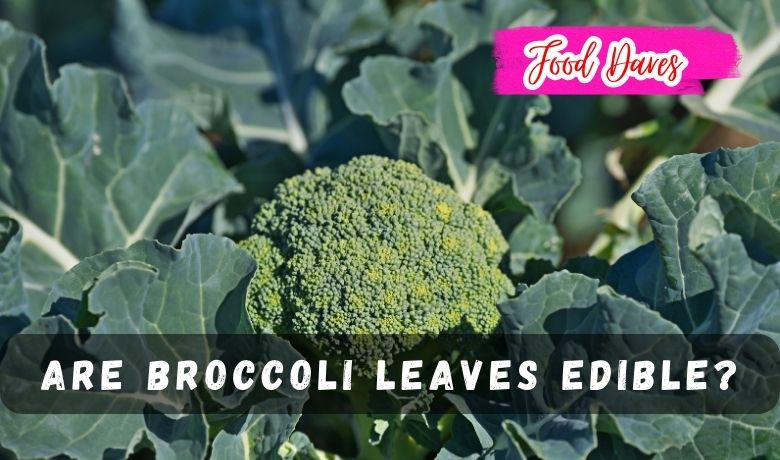When it comes to broccoli, most people immediately think of the crisp green florets that adorn their plates. However, there is a lesser-known part of this nutritious vegetable that often goes unnoticed—the leaves. Have you ever wondered if broccoli leaves are edible? Well, the truth might surprise you. These often overlooked greens are not only edible but also packed with valuable nutrients that can benefit your health. In this article, we will delve into the world of broccoli leaves, exploring their nutritional value, discussing their edibility, uncovering their health benefits, and even sharing some delicious recipes that will make you appreciate these vibrant and versatile greens. Get ready to unlock the hidden potential of broccoli leaves and add a delightful twist to your culinary adventures!
The Nutritional Value of Broccoli Leaves
Broccoli leaves, often overshadowed by the florets, are a nutritional powerhouse in their own right. Bursting with vitamins, minerals, and other essential compounds, these vibrant green leaves offer a range of health benefits. Here’s a closer look at the nutritional value they bring to the table:
- Rich in Vitamins: Broccoli leaves are an excellent source of vitamins. They are particularly high in vitamin C, an antioxidant that supports immune function and collagen production. Additionally, they provide significant amounts of vitamin A, which promotes healthy vision, and vitamin K, essential for blood clotting and bone health.
- Abundant Minerals: These leaves are also packed with essential minerals. They are a notable source of calcium, important for strong bones and teeth, as well as iron, which is crucial for oxygen transport and energy production. Broccoli leaves also contain potassium, magnesium, and manganese, supporting various bodily functions.
- Fiber Content: Fiber is an essential component of a healthy diet, and broccoli leaves offer a good amount of it. Dietary fiber aids digestion, promotes satiety, and helps maintain stable blood sugar levels.
- Antioxidant Powerhouse: Broccoli leaves contain a wealth of antioxidants that protect the body from oxidative stress. These antioxidants, including beta-carotene, lutein, and zeaxanthin, contribute to eye health, reduce inflammation, and may even help prevent chronic diseases.
- Phytochemicals: Broccoli leaves are rich in phytochemicals, including glucosinolates. These compounds have shown potential in cancer prevention by supporting detoxification processes and reducing inflammation.
Incorporating broccoli leaves into your meals can diversify your nutrient intake and provide a range of health-boosting benefits. So, don’t let these leafy greens go to waste; embrace their nutritional value and discover a delicious new way to nourish your body.
The Edibility of Broccoli Leaves
While the florets of broccoli often steal the spotlight, it’s time to shed some light on the edible potential of broccoli leaves. Contrary to popular belief, the leaves of broccoli are not only edible but also offer a delightful culinary experience. Here’s what you need to know about the edibility of broccoli leaves:
- Historical and Cultural Significance: Throughout history, many cultures have recognized the edibility of broccoli leaves. In traditional cuisines, these versatile greens have been used in various dishes, such as stir-fries, soups, and salads, showcasing their culinary value.
- Taste and Texture: Broccoli leaves possess a flavor profile similar to that of the florets, albeit milder and slightly earthy. The leaves offer a pleasant blend of bitterness and sweetness, with a tender yet slightly textured bite. When cooked, they become more tender, making them versatile for different cooking methods.
- Culinary Uses: Broccoli leaves can be incorporated into a wide range of dishes. They can be used as a substitute for other leafy greens, such as spinach or kale, in recipes like sautés, stews, and pasta dishes. The leaves can also be enjoyed raw in salads, providing a unique and refreshing twist.
- Harvesting and Preparation: When harvesting broccoli leaves, it’s best to select young and tender leaves from the plant. Choose leaves that are vibrant green, without signs of wilting or discoloration. Before use, ensure proper washing to remove any dirt or debris. Trim the leaves from the thick stalks and use them according to your preferred recipe.
- Organic and Homegrown Options: Opting for organic or homegrown broccoli leaves ensures that you are consuming pesticide-free greens. If you grow your own broccoli plants, you have the advantage of harvesting the leaves at their peak freshness, maximizing their flavor and nutritional value.
Discovering the edibility of broccoli leaves opens up a world of culinary possibilities. Whether you stir-fry them with garlic, add them to soups, or toss them into vibrant salads, these versatile greens offer a delightful addition to your meals. Don’t let the leaves go to waste; instead, embrace their culinary potential and elevate your dining experience with these nutritious gems.
Health Benefits of Eating Broccoli Leaves
Eating broccoli leaves goes beyond just satisfying your taste buds; it can significantly contribute to your overall well-being. Here are some remarkable health benefits associated with incorporating broccoli leaves into your diet:
- Cardiovascular Health: Broccoli leaves are known to promote a healthy heart. The presence of fiber, potassium, and antioxidants in these leaves supports cardiovascular function by helping to lower blood pressure, reduce cholesterol levels, and protect against oxidative stress.
- Enhanced Immune System: The high vitamin C content in broccoli leaves strengthens the immune system, enabling your body to fend off illnesses and infections more effectively. Vitamin C stimulates the production of white blood cells and antibodies, boosting the body’s natural defense mechanisms.
- Digestive Health: Broccoli leaves are rich in dietary fiber, which plays a vital role in maintaining a healthy digestive system. Adequate fiber intake promotes regular bowel movements, prevents constipation, and supports a diverse and thriving gut microbiome.
- Bone Health: The combination of calcium, magnesium, potassium, and vitamin K found in broccoli leaves contributes to strong and healthy bones. These nutrients aid in bone formation, density, and maintenance, reducing the risk of osteoporosis and fractures.
- Eye Protection: Broccoli leaves contain carotenoids, such as lutein and zeaxanthin, which are beneficial for eye health. These compounds help protect against age-related macular degeneration and cataracts, ensuring the longevity of your vision.
- Anti-inflammatory Effects: The presence of various antioxidants and phytochemicals in broccoli leaves provides anti-inflammatory benefits. By reducing inflammation in the body, these compounds may help lower the risk of chronic diseases, including heart disease, diabetes, and certain cancers.
- Detoxification Support: The phytochemicals known as glucosinolates found in broccoli leaves assist in the body’s detoxification processes. They aid in neutralizing and eliminating harmful substances, potentially reducing the risk of certain cancers and promoting overall well-being.
By including broccoli leaves in your meals, you can harness these health benefits and support your body’s optimal functioning. Experiment with different cooking methods and recipes to enjoy the wholesome advantages these vibrant greens have to offer.
Preparing and Cooking Broccoli Leaves
Broccoli leaves are not only edible but also offer a versatile addition to your culinary repertoire. Whether you’ve harvested fresh leaves from your own plants or purchased them at the market, preparing and cooking broccoli leaves is a straightforward and enjoyable process. Here are some tips to help you make the most of these vibrant greens:
Selecting and Storing:
- Choose fresh broccoli leaves with vibrant green color and crisp texture.
- Look for leaves that are free from wilting or yellowing.
- To store, wrap the leaves in a damp paper towel and place them in a perforated bag in the refrigerator. They should stay fresh for up to a week.
Cleaning and Preparing:
- Rinse the leaves thoroughly under cool running water to remove any dirt or debris.
- Trim off the tough stem ends of the leaves, as they can be fibrous and chewy.
- You can use the stems for other purposes, such as vegetable stock or compost.
Cooking Methods:
- Sautéing: Heat some olive oil or butter in a pan and add the cleaned and chopped broccoli leaves. Sauté them over medium heat until they wilt and become tender. Season with salt, pepper, and any desired herbs or spices.
- Steaming: Place the leaves in a steamer basket over boiling water and steam for a few minutes until they turn bright green and become tender. Avoid overcooking to retain their vibrant color and crispness.
- Boiling: Bring a pot of salted water to a boil and blanch the leaves for a minute or two. Drain them and immediately transfer them to an ice bath to preserve their color and texture. Use blanched leaves in salads or as a base for various recipes.
Creative Recipe Ideas:
- Use sautéed or steamed broccoli leaves as a side dish to accompany roasted meats or fish.
- Incorporate cooked leaves into omelets, frittatas, or quiches for added flavor and nutrition.
- Toss raw, thinly sliced leaves into salads for a vibrant and nutritious twist.
- Blend blanched broccoli leaves into pesto or add them to green smoothies for an extra nutrient boost.
By exploring different cooking methods and experimenting with recipes, you can fully appreciate the flavors and textures that broccoli leaves bring to your meals. Embrace their versatility and nutritional value to create delightful dishes that showcase these often overlooked greens.
Delicious Recipes Using Broccoli Leaves
Broccoli leaves offer a delightful twist to your culinary adventures, bringing unique flavors and textures to your dishes. From sautés to salads, there are countless ways to incorporate these vibrant greens into your favorite recipes. Here are a few delicious ideas to get you started:
Broccoli Leaf Stir-Fry:
- Heat some sesame oil in a pan and add minced garlic and ginger.
- Sauté chopped broccoli leaves until they wilt and become tender.
- Add soy sauce, a splash of rice vinegar, and a pinch of red pepper flakes for a kick of flavor.
- Toss in some cooked protein, such as tofu or shrimp, and serve over steamed rice or noodles.
Broccoli Leaf Pesto Pasta:
- Blend blanched broccoli leaves, garlic, toasted pine nuts, grated Parmesan cheese, and olive oil in a food processor until smooth.
- Cook your favorite pasta according to the package instructions and toss it with the prepared pesto.
- Add cherry tomatoes, sliced olives, or grilled chicken for extra flavor and texture.
Broccoli Leaf and Quinoa Salad:
- Cook quinoa according to package instructions and let it cool.
- In a large bowl, combine chopped broccoli leaves, cooked quinoa, diced tomatoes, cucumber, feta cheese, and chopped fresh herbs like parsley or basil.
- Drizzle with lemon juice, extra virgin olive oil, salt, and pepper. Toss well to combine and serve as a refreshing and nutritious salad.
Broccoli Leaf Wraps:
- Blanche broccoli leaves to make them pliable.
- Spread a layer of hummus or cream cheese on the leaves.
- Add your choice of fillings such as sliced roasted turkey, avocado, shredded carrots, and sprouts.
- Roll up the leaves tightly and secure with toothpicks for a healthy and vibrant wrap.
Broccoli Leaf and Potato Soup:
- Sauté diced onions, garlic, and cubed potatoes in a pot with olive oil until softened.
- Add vegetable or chicken broth, chopped broccoli leaves, and season with salt, pepper, and herbs like thyme or rosemary.
- Simmer until the potatoes are tender and the flavors meld together. Blend the soup until smooth, if desired, or leave it chunky for texture.
These recipes are just a starting point to inspire your culinary creativity. Feel free to experiment with different combinations of flavors and ingredients to make the most of the versatile and nutritious broccoli leaves. Let your taste buds guide you as you explore the delicious possibilities these vibrant greens have to offer.
Safety and Precautions
While incorporating broccoli leaves into your meals can be a flavorful and nutritious choice, it is essential to be aware of certain safety considerations and take necessary precautions. Here are some guidelines to ensure the safe consumption of broccoli leaves:
Pesticide Concerns:
- If purchasing broccoli leaves, opt for organic or locally sourced options to minimize exposure to pesticides.
- If you grow your own broccoli plants, avoid using chemical pesticides and opt for organic pest control methods.
- Thoroughly wash the leaves under cool running water to remove any residual pesticides or dirt.
Thorough Washing:
- Before cooking or consuming, ensure that you wash broccoli leaves thoroughly to remove any dirt, debris, or potential contaminants.
- Gently rub the leaves with your fingers while rinsing to ensure all surfaces are clean.
- Use clean, running water or soak the leaves in a bowl of water for a few minutes to aid in the removal of any stubborn particles.
Allergies and Sensitivities:
- Like other members of the Brassica family, such as cabbage or kale, broccoli leaves may cause allergic reactions in some individuals.
- If you have known allergies or sensitivities to these vegetables, exercise caution when consuming broccoli leaves and consult with a healthcare professional if needed.
Cooking Times and Storage:
- Cook broccoli leaves thoroughly to ensure they reach a safe temperature, especially if consuming them raw poses a potential risk.
- Store cooked broccoli leaves in airtight containers in the refrigerator and consume within a few days to maintain freshness and reduce the risk of spoilage.
Personalized Dietary Needs:
- Consider your individual dietary needs and any specific dietary restrictions when incorporating broccoli leaves into your meals.
- If you have any underlying health conditions or concerns, it is advisable to consult with a healthcare professional or registered dietitian before making significant dietary changes.
By following these safety precautions and guidelines, you can enjoy the many benefits of incorporating broccoli leaves into your diet while minimizing potential risks. It is always important to prioritize food safety and make informed decisions when it comes to your health and well-being.
Conclusion
Broccoli leaves are not only edible but also offer a range of nutritional benefits and culinary possibilities. Packed with vitamins, minerals, fiber, and antioxidants, these vibrant greens contribute to cardiovascular health, immune function, digestive well-being, and more. With their mild yet flavorful taste, broccoli leaves can be sautéed, steamed, boiled, or enjoyed raw in salads and wraps. However, it is crucial to prioritize safety by washing them thoroughly, considering pesticide exposure, and being aware of individual allergies or sensitivities. By incorporating broccoli leaves into your meals, you can elevate your culinary experiences while reaping the health rewards these often overlooked greens have to offer.



